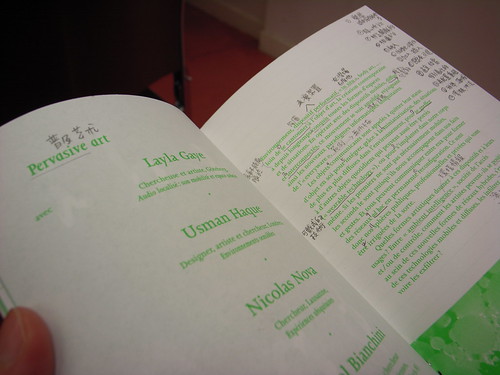 Finally managed to get some time to write down my notes from the conference I attended last week in Paris. Called "Mobilisable" and organized at the Ecole Nationale Supérieure des Arts Décoratifs, the conference was both a scientific and art event about focused on mobility and the hybridization of technologies, environments, objects and people. The whole point of the event was to highlight and illustrate the current mutations at stake in interaction design, new media art and new mapping forms.
Finally managed to get some time to write down my notes from the conference I attended last week in Paris. Called "Mobilisable" and organized at the Ecole Nationale Supérieure des Arts Décoratifs, the conference was both a scientific and art event about focused on mobility and the hybridization of technologies, environments, objects and people. The whole point of the event was to highlight and illustrate the current mutations at stake in interaction design, new media art and new mapping forms.
The first session was about relational cartographies, maps and mobilities.
Boris Beaude started off by describing the problems to visualize mobility on maps. Some of them are due to the inherent characteristics of maps:
- Mobility implies time, a diachronic dimension; so it's difficult to represent this on a map.
- Maps generally represents aggregates of people, not individuals
- Maps impose an euclidian metric, everything is laid down on a plan so it's difficult to represent different layers.
This is why most of the map depict means of transport, instead of mobilities. In addition, geographers like Boris are experimenting a shift in map design: they try to represent the "space of individuals". He showed results from a project called Scalab in which they asked people to describe their own mobility and map the results on graphics. This type of visualizations allows to show different set of practices. He also talked about projects such as Real Time Rome or Facebook Palantir to show how this sort of visualizations of maps is a evolution of mobilities, that spatial practices are different and that art is inteing as it manages to uncover new forms of representations beyond what geographers are building.
Then Philippe Vasset talked about an interesting book he just wrote about holes in maps: the white spaces you can find on maps where nothing is represented. He explored different white spaces in Paris area, documenting what sort of stuff you can find there.
 (Map produced by Bureau d'Etude about the crisis in Argentina)
(Map produced by Bureau d'Etude about the crisis in Argentina)
And finally, Bureau d'Etudes showed their different projects and the underlying rationale or process to design them. Their objective is to represent the world and its components with a subjective approach using visualizations tools and abstract maps. They discussed how this kind of representations have an important critical component. They basically focus on creating informational maps whose purpose is to visually represent different facets of contemporary capitalism: corporations, industrial and financial or influential groups.
 (The conference leaflet annotated by my chinese neighbor)
(The conference leaflet annotated by my chinese neighbor)
The next session was about "pervasive art", i.e. how artists and designers envision the internet of things as well as ubiquitous computing. Lalya Gaye, Usman Haque and myself discussed the role of these practitioners in the field.
As a first speaker, I showed why and how designers and new media artists are paving the way for the near future. After a quick introduction of ubiquitous computing and a description of the current challenges, the other part of the talk was a rerun of my why art/design is meaningful to HCI research.
The second speaker, Lalya Gaye gave a great presentation about audio projects in urban environment. What was highly inspiring was that she grounded the discussion about these projects (hers as well as some made by others) in a very relevant design rationale:
- The iPhone is a presented as the optimal mobility object but she thinks it's not the case. Not simply because the text input sucks to send messages in less than 10 seconds but rather because there are other possibilities which interest her better. Using the city as an interface is such approach
- The second reason is more aesthetical: urban space, beyond its surface, provides lots of potential affordances that can be creative. For instance, an handlebar can be use by skateboarders, a surface can be filled with stickers, staircases can be employed for parkour, etc. Mundane objects can indeed be seen as having other characteristics: handrails in stairs can be perceived as a way to generate music according to a certain pattern.
- Daily actions, such as mobility, can be turned (or doubled) into new signfications.
She presented various audio projects built on these principles and concluded with this intriguing question: "what if the augmentation of objects and activities through this process may change the initial meaning of these? Do we get rid of the original object's signification?".
Finally, Usman Haque gave a great a talk (in french!) about his projects to show four key ideas:
- Traditionally, people think architecture is about hard material (walls, ceilings) but for Usman, it's what remains: between walls, smell, temperature, social relationships, things that help the perception of space, etc.
- Technology versus instruments: people generally thinks technology is an object but it's a system of relations to "do sth". He said that "nobody takes a frog and say 'this biology is great'". He prefers the notion of instruments.
- User versus Participant: users imply that there are designers and passive users... which is why he prefers the notion of participants.
- Publis space versus commons: now that space is filled with surveillance technologies, where are the boundaries between private and public space?
Why do I blog this my notes from this insightful sessions. Good material from interesting speakers. Some good things to sleep on and re-inject in current projects.
Thanks Samuel Bianchini for the invitation.